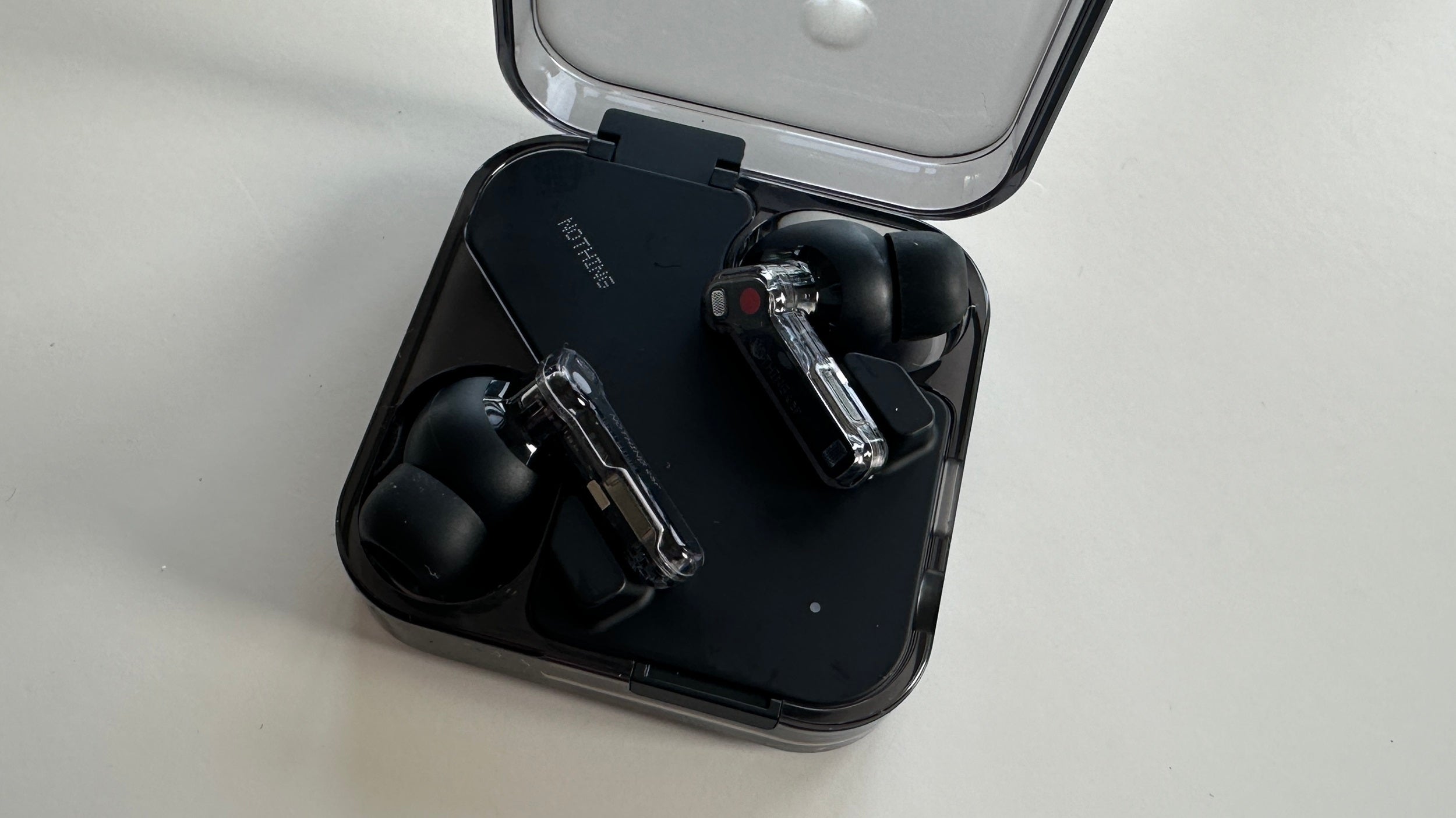Verdict
Whether or not you’re a big fan of the Nothing Ear will depend on whether you think getting two sounds for the price of one is a good thing or not
Pros
- Swift, confident and quite dynamic sound
- Thoroughly specified
- Well-sorted control options
Cons
- ANC influences sound…
- …so the sonic balance is subject to unsolicited change
- More fit-dependent than your average TWS
-
Drivers11mm ceramic-diaphragm drivers -
Bluetooth supportBluetooth 5.3 with SBC, AAC, LHDC, LDAC codec compatibility -
Battery40 hours of battery life (including charging case)
Introduction
You know Nothing by now, right? It’s the brand that wants to differentiate itself from all the other brands that are involved in smartphones, true wireless earbuds and the like by majoring on design, being absolutely as literal as possible when it comes to deciding on model names, and offering the sort of performance-per-pound that its nominal rivals can’t lay a glove on.
The latest manifestation of the Nothing ethos is here. The Ear true wireless in-ear headphones, rather counterintuitively, follow on from the Ear (1) and Ear (2) models – they launch at the same time as the more affordable Ear (a) that replace the Ear (stick).
That’s a lot of parentheses, isn’t it? After all that, let’s hope the Nothing Ear are something worth listening to…
Availability
The Nothing Ear are on sale in the UK for £129. In the United States they go for $149, while in Australia they’re likely to be AU$249 if knowledge of exchange rates is anything to go by.
Nothing likes to think it does things differently, but that doesn’t mean the Ear don’t have plenty of price- and spec-comparable competition. Everyone from Edifier to Sony (and most points in between) has an alternative with which to tempt you…
Design
- The customary Nothing transparency
- App and pinch control
- Vented dual-chamber enclosure
If Nothing has established anything where design is concerned, it’s that it likes to be as transparent as possible. So the Ear follow the template established by their predecessors, and have the insides of the stem portion visible through clear plastic.
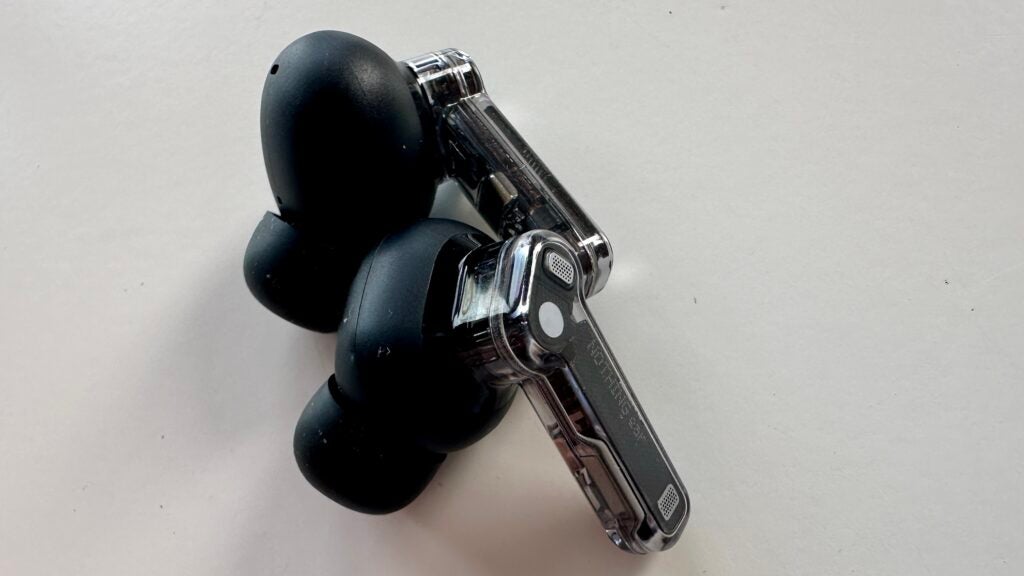
The enclosure at the top of the stem is not see-through, so we all have to take Nothing’s word for it that the dual-chamber design now features two additional vents when compared to Ear (2) – the intention is to help smooth airflow. The enclosure itself is, relatively speaking, quite bulky – but nevertheless, its ergonomic shape and the choice of three sizes of silicone ear-tips make getting the Ear comfortably positioned no great hardship.
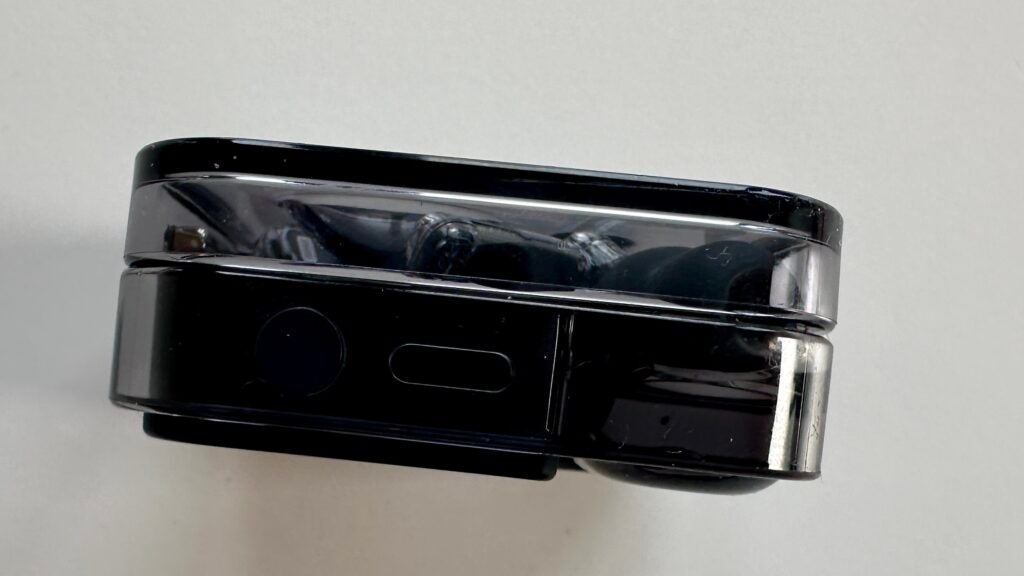
The stem of each earbud features a pinch, rather than a touch control. Quite often, physical controls on true wireless earbuds can disrupt the fit, but the pinch controls here are nicely implemented and don’t disturb the way the Ear sit in your ear.
Features
- 11mm ceramic-diaphragm drivers
- Bluetooth 5.3 with SBC, AAC, LHDC and LDAC codec compatibility
- Up to 40 hours of battery life
There’s certainly no arguing with the lengths Nothing has gone to where the specification of the ear is concerned. In terms of size and weight, these stem-style earbuds are unremarkable – but the features are crammed in.
Wireless connectivity, for instance, is via Bluetooth 5.3 – and in addition to your standard SBC and AAC codecs, the Ear are also compatible with LHDC and LDAC. So if you have an appropriate source player, lossy hi-res audio is on the menu. And no matter how the content is streamed, it’s delivered to your ears via a couple of 11mm full-range dynamic drivers that use ceramic as a diaphragm material – Nothing reckons this material offers optimum stiffness, frequency response and sonic clarity.
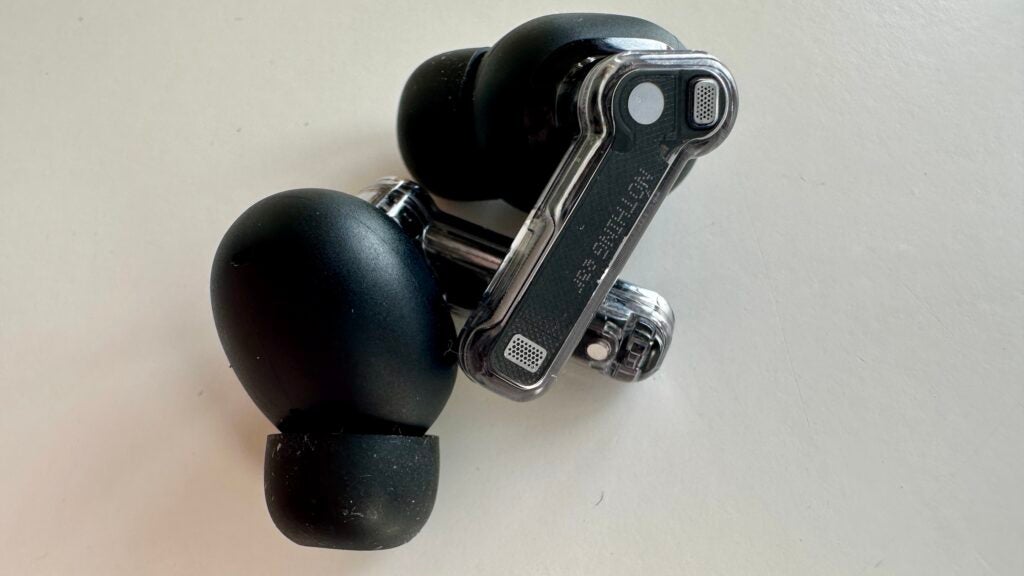
With active noise-cancellation switched off, the earbuds can run for over eight hours between charges. Switch it on and that figure drops to more like five hours. There’s a further four full charges in the little case, though, so you’re looking at anywhere between 24 and 40 hours of playback time before you have any need of mains power. Charging happens either via the case’s USB-C slot or any Qi-certified wireless charging pad – just 10 minutes should be enough for around 10 hours of non-ANC action.
The active noise-cancellation itself is a system that can be switched off, set to Transparency or to one of four ‘on’ states: High, Mid, Low or Adaptive. Adaptive basically decides on the level of ANC you get depending on your environment – three mics per earbud, plus an AI noise-reduction algorithm, assess your surroundings as well as dealing with Clear Voice Technology-assisted call quality.
There’s multipoint connectivity for the sake of convenience, a low-lag mode for a smooth gaming experience, and IP54 (earbuds) and IP55 (charging case) ratings that indicate worthwhile resistance to moisture and dust.
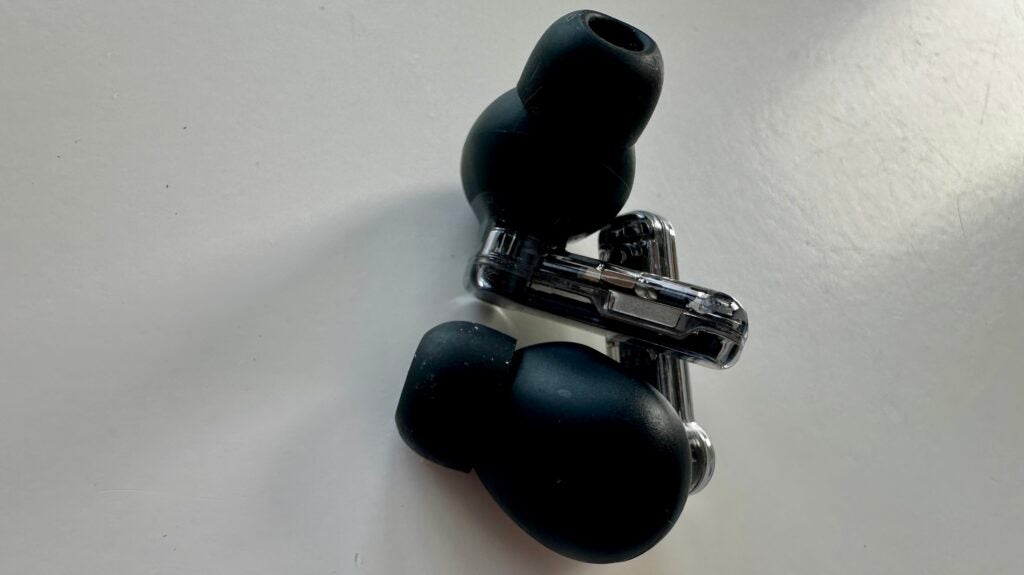
The function of the controls can be defined in the Nothing X control app that’s free for iOS and Android. The play/pause and answer/end call controls can’t be altered, but it’s possible to arrange skip forwards, skip backwards, summon voice assistant, volume up, volume down, decline call and cycle through ANC options to your own specification.
The app is clear, comprehensive and useful – which is more than can be said for some alternative designs. It features a couple of equaliser options – one is a simple graphic interface (with four presets), the other an altogether more in-depth eight-band EQ with the option to save a custom setting or two.
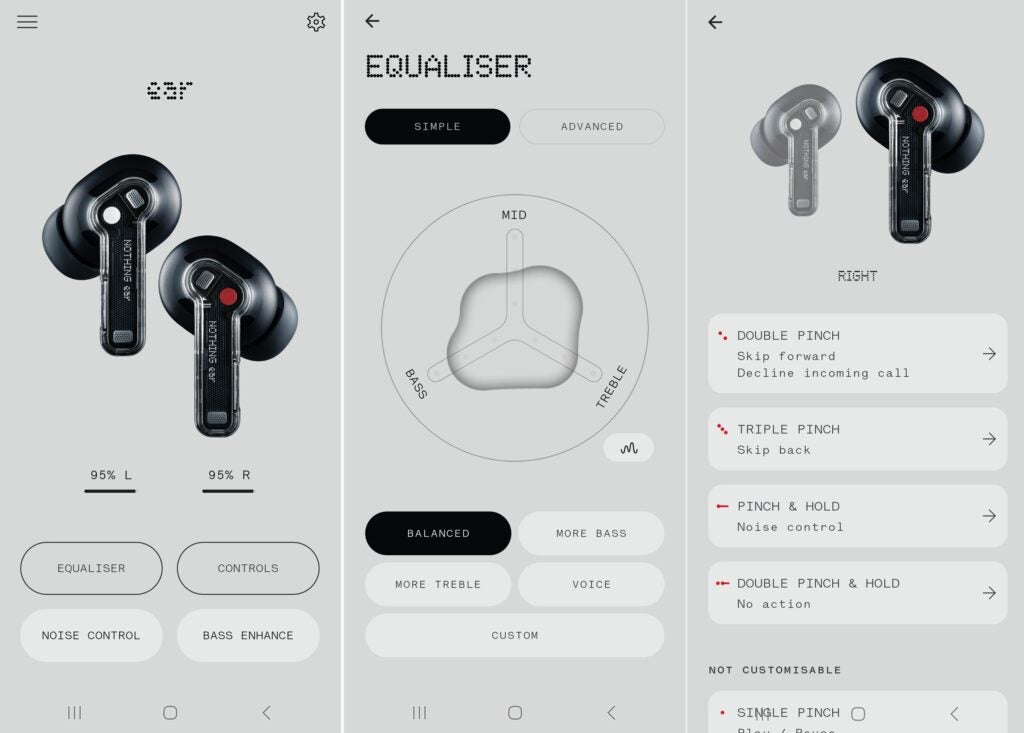
Here’s where you can decide on your default ANC setting, cycle through five stages of Bass Enhance (take a wild guess), check for software updates and on the state of play as regards battery level, switch Low Lag Mode on or off (one for the gamers) and plenty more besides. It also features a hearing test to try and establish a Personal Sound Profile and an ear-tip fit test’ to, well, establish if your ear-tips fit properly or not.
Sound Quality
- Rapid, energetic sound
- Punch and drive in equal measure
- ANC can skew sound significantly
First off, I’m going to talk about the way the Nothing Ear sound with active noise-cancellation switched off, Bass Enhance left well alone and EQ settings flat. In theory, this should mean unadulterated Ear performance and work as a benchmark where sound personalisation features are concerned.
And heard in this condition, there’s a lot to like about the Nothing Ear – perky is perhaps too weak a word to describe their attitude. Prince’s Play in the Sunshine absolutely charges along, the Nothing keeping the rhythm moving forwards and maintaining momentum throughout the frequency range.
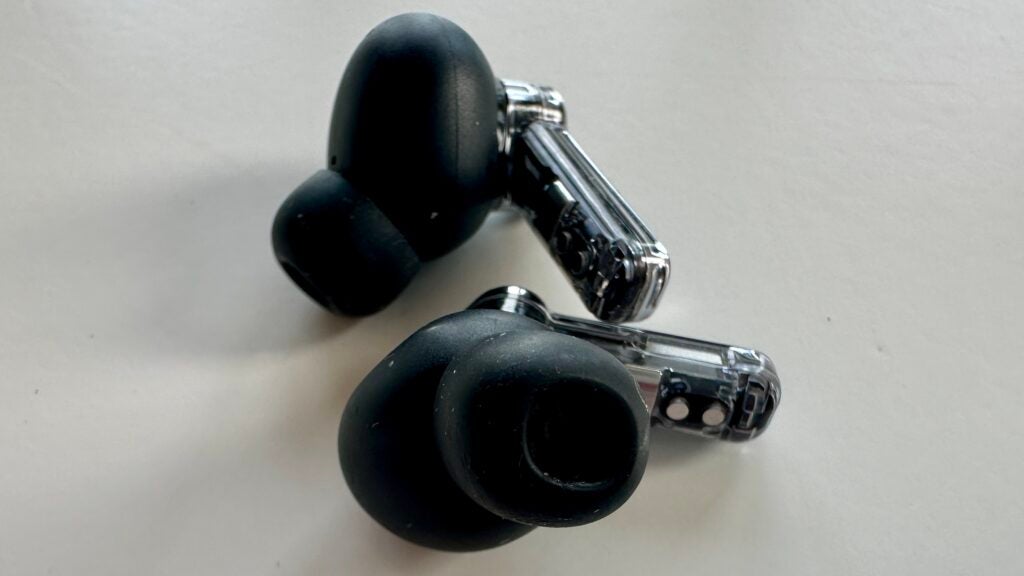
It’s not the heftiest sound you ever heard, true – but the low frequencies have decent impact and straight-edged control, which goes a long way towards making up for their relative lack of outright substance. The top of the frequency range is bright and rapid, but even at fairly significant volumes it’s substantial rather than hard. And in between, the inimitable vocal is expressed fully – there’s a full serving of character and attitude.
Detail levels are reasonably high, and the Ear have plenty of observations to make about the texture of individual instruments as well as keeping an eye on the transient occurrences at the edge or back of the (big, spacious and well-defined) soundstage. They can spot and contextualise the harmonic variations in the keyboards that only really become obvious during the breaks – and they do so without drawing undue attention or detracting for the overall unity of their presentation.
They have considerable dynamic headroom, too, as a quick pass through Storm by Godspeed You! Black Emperor confirms. The distance between the quietest and the most intense sections of this recording is significant – and that’s just how the Ear make it seem.
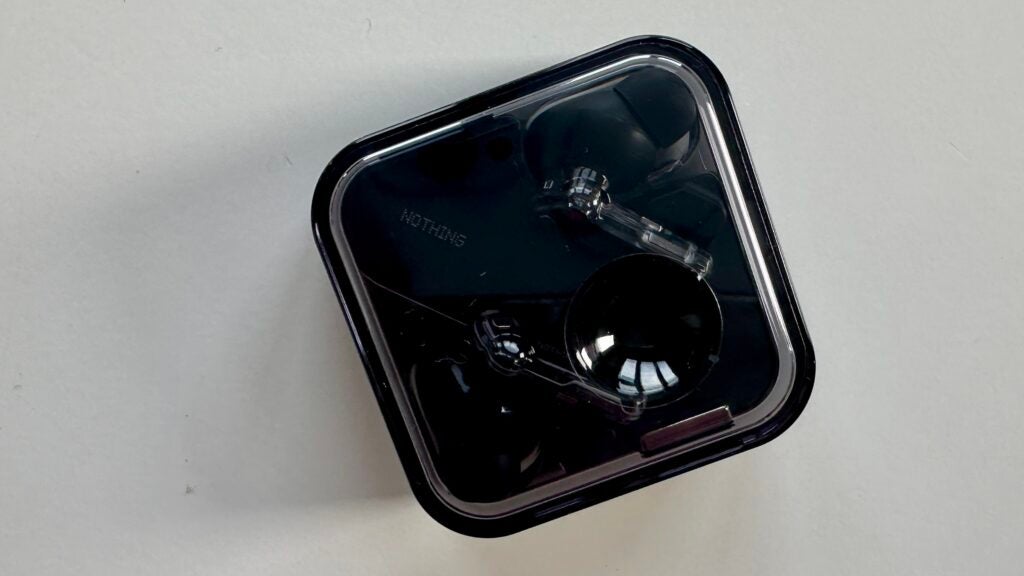
Overall, the Ear present a balanced and coherent sound in confident manner, unifying the frequency range well and making up for in rapidity what they lack in outright wallop. Switch the active noise-cancellation on, though, and it becomes a slightly different story…
With ANC on, suddenly that low-frequency substance is apparent and the almost hectic momentum of the Ear sound is tempered somewhat. The noise-cancellation itself would seem to be fairly effective – but in all honesty it’s just slightly difficult to tell, because the abrupt emphasis on the bottom of the frequency range tends to mask some external sounds all by itself.
It’s been a long time since I listened to a pair of noise-cancelling headphones that change their sonic character quite so fundamentally when they’re doing their noise-cancelling thing, and I’m really not all that keen. Nothing offers the Ear owner quite a few different options to actively alter the sound, so it doesn’t seem all that sensible that involuntary changes should be effected by a feature that shouldn’t have any input into sound quality at all.
Latest deals
Should you buy it?
You enjoy an energetic and whippet-lean sound
There’s speed and momentum to burn in the way the Ear deliver
You want to be the only one altering the way they sound
The whole sonic emphasis of the Ear changes once you engage ANC
Final Thoughts
I like Nothing – the company’s not as radical as it seems to think it is, but it’s got some very worthwhile products in its line-up that always represent decent value for money. The Nothing Ear fall into that category too – but no two ways about it, the way they change their character as soon as ANC is switched on is just weird.
How we test
We test every set of headphones we review thoroughly over an extended period of time. We use industry standard tests to compare features properly. We’ll always tell you what we find. We never, ever, accept money to review a product.
Find out more about how we test in our ethics policy.
Tested with real world use
FAQs
You can get 24 hours (including the charging case) from the Nothing Ear with ANC. Turn ANC off and that extends battery life to 40.5 hours.
Verdict
Whether or not you’re a big fan of the Nothing Ear will depend on whether you think getting two sounds for the price of one is a good thing or not
Pros
- Swift, confident and quite dynamic sound
- Thoroughly specified
- Well-sorted control options
Cons
- ANC influences sound…
- …so the sonic balance is subject to unsolicited change
- More fit-dependent than your average TWS
-
Drivers11mm ceramic-diaphragm drivers -
Bluetooth supportBluetooth 5.3 with SBC, AAC, LHDC, LDAC codec compatibility -
Battery40 hours of battery life (including charging case)
Introduction
You know Nothing by now, right? It’s the brand that wants to differentiate itself from all the other brands that are involved in smartphones, true wireless earbuds and the like by majoring on design, being absolutely as literal as possible when it comes to deciding on model names, and offering the sort of performance-per-pound that its nominal rivals can’t lay a glove on.
The latest manifestation of the Nothing ethos is here. The Ear true wireless in-ear headphones, rather counterintuitively, follow on from the Ear (1) and Ear (2) models – they launch at the same time as the more affordable Ear (a) that replace the Ear (stick).
That’s a lot of parentheses, isn’t it? After all that, let’s hope the Nothing Ear are something worth listening to…
Availability
The Nothing Ear are on sale in the UK for £129. In the United States they go for $149, while in Australia they’re likely to be AU$249 if knowledge of exchange rates is anything to go by.
Nothing likes to think it does things differently, but that doesn’t mean the Ear don’t have plenty of price- and spec-comparable competition. Everyone from Edifier to Sony (and most points in between) has an alternative with which to tempt you…
Design
- The customary Nothing transparency
- App and pinch control
- Vented dual-chamber enclosure
If Nothing has established anything where design is concerned, it’s that it likes to be as transparent as possible. So the Ear follow the template established by their predecessors, and have the insides of the stem portion visible through clear plastic.

The enclosure at the top of the stem is not see-through, so we all have to take Nothing’s word for it that the dual-chamber design now features two additional vents when compared to Ear (2) – the intention is to help smooth airflow. The enclosure itself is, relatively speaking, quite bulky – but nevertheless, its ergonomic shape and the choice of three sizes of silicone ear-tips make getting the Ear comfortably positioned no great hardship.

The stem of each earbud features a pinch, rather than a touch control. Quite often, physical controls on true wireless earbuds can disrupt the fit, but the pinch controls here are nicely implemented and don’t disturb the way the Ear sit in your ear.
Features
- 11mm ceramic-diaphragm drivers
- Bluetooth 5.3 with SBC, AAC, LHDC and LDAC codec compatibility
- Up to 40 hours of battery life
There’s certainly no arguing with the lengths Nothing has gone to where the specification of the ear is concerned. In terms of size and weight, these stem-style earbuds are unremarkable – but the features are crammed in.
Wireless connectivity, for instance, is via Bluetooth 5.3 – and in addition to your standard SBC and AAC codecs, the Ear are also compatible with LHDC and LDAC. So if you have an appropriate source player, lossy hi-res audio is on the menu. And no matter how the content is streamed, it’s delivered to your ears via a couple of 11mm full-range dynamic drivers that use ceramic as a diaphragm material – Nothing reckons this material offers optimum stiffness, frequency response and sonic clarity.

With active noise-cancellation switched off, the earbuds can run for over eight hours between charges. Switch it on and that figure drops to more like five hours. There’s a further four full charges in the little case, though, so you’re looking at anywhere between 24 and 40 hours of playback time before you have any need of mains power. Charging happens either via the case’s USB-C slot or any Qi-certified wireless charging pad – just 10 minutes should be enough for around 10 hours of non-ANC action.
The active noise-cancellation itself is a system that can be switched off, set to Transparency or to one of four ‘on’ states: High, Mid, Low or Adaptive. Adaptive basically decides on the level of ANC you get depending on your environment – three mics per earbud, plus an AI noise-reduction algorithm, assess your surroundings as well as dealing with Clear Voice Technology-assisted call quality.
There’s multipoint connectivity for the sake of convenience, a low-lag mode for a smooth gaming experience, and IP54 (earbuds) and IP55 (charging case) ratings that indicate worthwhile resistance to moisture and dust.

The function of the controls can be defined in the Nothing X control app that’s free for iOS and Android. The play/pause and answer/end call controls can’t be altered, but it’s possible to arrange skip forwards, skip backwards, summon voice assistant, volume up, volume down, decline call and cycle through ANC options to your own specification.
The app is clear, comprehensive and useful – which is more than can be said for some alternative designs. It features a couple of equaliser options – one is a simple graphic interface (with four presets), the other an altogether more in-depth eight-band EQ with the option to save a custom setting or two.

Here’s where you can decide on your default ANC setting, cycle through five stages of Bass Enhance (take a wild guess), check for software updates and on the state of play as regards battery level, switch Low Lag Mode on or off (one for the gamers) and plenty more besides. It also features a hearing test to try and establish a Personal Sound Profile and an ear-tip fit test’ to, well, establish if your ear-tips fit properly or not.
Sound Quality
- Rapid, energetic sound
- Punch and drive in equal measure
- ANC can skew sound significantly
First off, I’m going to talk about the way the Nothing Ear sound with active noise-cancellation switched off, Bass Enhance left well alone and EQ settings flat. In theory, this should mean unadulterated Ear performance and work as a benchmark where sound personalisation features are concerned.
And heard in this condition, there’s a lot to like about the Nothing Ear – perky is perhaps too weak a word to describe their attitude. Prince’s Play in the Sunshine absolutely charges along, the Nothing keeping the rhythm moving forwards and maintaining momentum throughout the frequency range.

It’s not the heftiest sound you ever heard, true – but the low frequencies have decent impact and straight-edged control, which goes a long way towards making up for their relative lack of outright substance. The top of the frequency range is bright and rapid, but even at fairly significant volumes it’s substantial rather than hard. And in between, the inimitable vocal is expressed fully – there’s a full serving of character and attitude.
Detail levels are reasonably high, and the Ear have plenty of observations to make about the texture of individual instruments as well as keeping an eye on the transient occurrences at the edge or back of the (big, spacious and well-defined) soundstage. They can spot and contextualise the harmonic variations in the keyboards that only really become obvious during the breaks – and they do so without drawing undue attention or detracting for the overall unity of their presentation.
They have considerable dynamic headroom, too, as a quick pass through Storm by Godspeed You! Black Emperor confirms. The distance between the quietest and the most intense sections of this recording is significant – and that’s just how the Ear make it seem.

Overall, the Ear present a balanced and coherent sound in confident manner, unifying the frequency range well and making up for in rapidity what they lack in outright wallop. Switch the active noise-cancellation on, though, and it becomes a slightly different story…
With ANC on, suddenly that low-frequency substance is apparent and the almost hectic momentum of the Ear sound is tempered somewhat. The noise-cancellation itself would seem to be fairly effective – but in all honesty it’s just slightly difficult to tell, because the abrupt emphasis on the bottom of the frequency range tends to mask some external sounds all by itself.
It’s been a long time since I listened to a pair of noise-cancelling headphones that change their sonic character quite so fundamentally when they’re doing their noise-cancelling thing, and I’m really not all that keen. Nothing offers the Ear owner quite a few different options to actively alter the sound, so it doesn’t seem all that sensible that involuntary changes should be effected by a feature that shouldn’t have any input into sound quality at all.
Latest deals
Should you buy it?
You enjoy an energetic and whippet-lean sound
There’s speed and momentum to burn in the way the Ear deliver
You want to be the only one altering the way they sound
The whole sonic emphasis of the Ear changes once you engage ANC
Final Thoughts
I like Nothing – the company’s not as radical as it seems to think it is, but it’s got some very worthwhile products in its line-up that always represent decent value for money. The Nothing Ear fall into that category too – but no two ways about it, the way they change their character as soon as ANC is switched on is just weird.
How we test
We test every set of headphones we review thoroughly over an extended period of time. We use industry standard tests to compare features properly. We’ll always tell you what we find. We never, ever, accept money to review a product.
Find out more about how we test in our ethics policy.
Tested with real world use
FAQs
You can get 24 hours (including the charging case) from the Nothing Ear with ANC. Turn ANC off and that extends battery life to 40.5 hours.



















